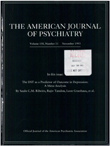Relations among clinical scales in schizophrenia
Abstract
OBJECTIVE: Clinical scales have become established as tools to quantify phenomenological features of schizophrenia. The goal of this study was to examine relations among the following: the Brief Psychiatric Rating Scale (BPRS), the Scale for the Assessment of Positive Symptoms, the Scale for the Assessment of Negative Symptoms, and the deficit- nondeficit classification. METHOD: Forty-seven patients with schizophrenia were recruited according to specific inclusion and exclusion criteria. The standardized assessment procedures were administered by a trained psychiatric research team. RESULTS: Examination of the BPRS showed that the patients had highest scores on the thought disorder factor and the symptoms specific to schizophrenia. Classification of patients as having the positive, negative, or mixed type of schizophrenia resulted in a finding of seven with the positive, seven with the negative, and 33 with the mixed type. The division of patients into those with the deficit syndrome (N = 29) and those without (N = 18) was related to symptom specificity and to positive and negative symptoms. Deficit syndrome patients had more symptoms specific to schizophrenia, fewer nonspecific symptoms, and, as expected, greater severity of negative symptoms. Cluster analysis revealed three clusters of patients: those with low negative symptom scores and high scores on specific symptoms (the majority were without the deficit syndrome); those with high scores on negative, positive, and specific symptoms (the majority had the deficit syndrome); and those with lower scores on specific symptoms and high scores on negative and positive symptoms (the majority had the deficit syndrome). CONCLUSIONS: The scales showed some overlap but also seemed to measure complementary aspects of the phenomenology of schizophrenia. Subtypes of patients identified by the combined use of these scales may differ in underlying pathology.
Access content
To read the fulltext, please use one of the options below to sign in or purchase access.- Personal login
- Institutional Login
- Sign in via OpenAthens
- Register for access
-
Please login/register if you wish to pair your device and check access availability.
Not a subscriber?
PsychiatryOnline subscription options offer access to the DSM-5 library, books, journals, CME, and patient resources. This all-in-one virtual library provides psychiatrists and mental health professionals with key resources for diagnosis, treatment, research, and professional development.
Need more help? PsychiatryOnline Customer Service may be reached by emailing [email protected] or by calling 800-368-5777 (in the U.S.) or 703-907-7322 (outside the U.S.).



